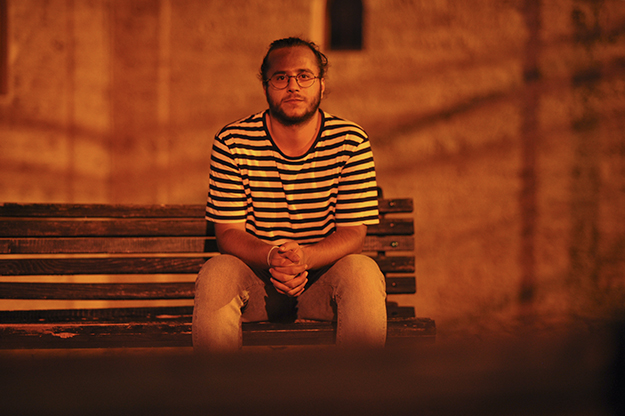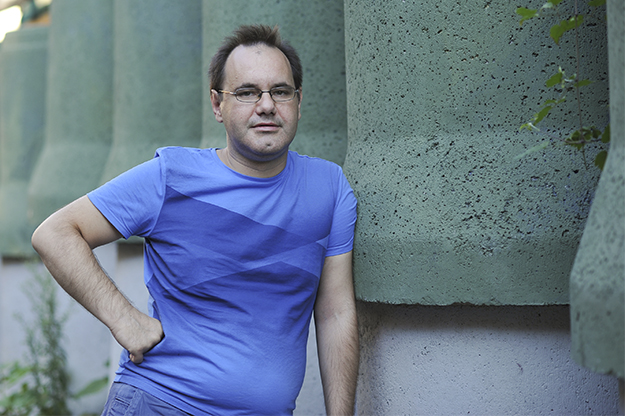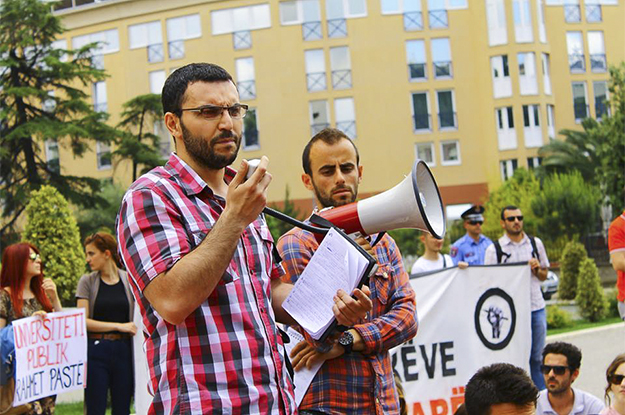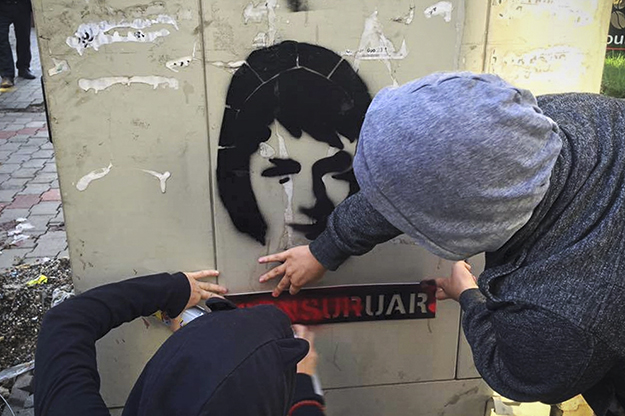On November 17, 1966, Durrës was hit by a storm. The weather was inflicting damage on the city, most critically in the port, where the waves and the wind were threatening to crash its container crane.
Workers were trying to reduce the damages and keep the crane on its feet. Among them was Adem Reka, who with his 15 years of working experience was doing his bit. Despite being on vacation that day, he went to work for what would turn out to be the last time. One of the metal cables carrying the crane broke and hit Adem Reka’s head, causing fatal injuries.
The 39-year-old’s death didn’t pass in silence. The country’s highest officials reacted with grief, labelling Reka as a model for communist Albanian society. They did not acknowledge responsibility for his death, nor did they talk about conditions or safety at work. Instead, they organized marches from all over Albania toward the port of Durres.
People walked from miles away from every district in Albania to honor the dead worker. But the regime at the time did not stop with just the march. They declared Adem Reka a “Hero of Socialist Work” and for 45 years of communist dictatorship he was used as a model of “how to be a socialist worker.”
Reka’s story is told in the documentary “Adem Reka,”’ directed by Ardian Arrëza, which was screened as part of the National competition at this year’s DokuFest. The 25-year-old director from Durrës had a school assignment to produce a documentary on the theme of ‘Dealing With the Past.’ Starting from this point, he began to explore the past of his city, and in conversations with his father, the story of Reka came up. It was one he had heard before.

The documentary “Adem Reka” from director Ardian Arrëza, which was screened in the National category at this year’s DokuFest shows how the communist system of the time would turn workplace disasters into heroic stories. Photo: Atdhe Mulla / K2.0.
He was more excited about the story when he realized that some of his acquaintances knew the story of Reka, while others didn’t. Those who knew about the event were divided over “whether he deserved the title of ‘hero’ or not,” which prompted Arrëz to start to explore further and ultimately bring the story to the big screen.
The first discovery was a postage stamp with the name Reka. “I was impressed,” Arrëza tells K2.0, commenting on how it looked. “Adem is fighting with the waves, with one passing overhead. It looks like Catholic iconography.”
For Arrëza it’s strange how the system at the time would turn workplace disasters into heroic stories: “Having no idols, these heroes are perfect for communism because they die at work and give their own life to work for the homeland,” he says, trying to analyze such an action.
Arrëza doesn’t like speaking about his work, leaving the talking instead to the documentary. When he speaks about the story of Adem Reka, he does it through the words of the people who feature in his film and lived through the event. He remembers the words of Adem’s daughter. For her, the whole story was a disaster for the family.
In the documentary she emphasizes the difficult moments her family went through and the use of his death by the regime. She recalls the gossiping of that time, that her mother was traveling to Korea and other communist countries and was being treated well by the regime. According to her, none of this was true, stating that her mother never set foot outside Albania.
Adem’s daughter remembers that her mother was worried about the marches that were organized for her husband. “Obo! Obo! They will curse Adem,” she said, fearing that they will blame Reka for forcing them to march to Durres.
Workers’ rights in Communist Albania
Among the people who walked more than 35 kilometers from Tirana to Durrës was Gjergj Erebara’s mother. Erebara, a journalist from Tirana, remembers it well and insists that these marches were obligatory even though they seemed as if they were participated in voluntarily.
According to Erebara, fatal accidents at work were frequent during that time and the regime sometimes decided to use them for propaganda. For Erabara, this was a message to tell people that “the regime expects you to die at work. Your life does not matter… it is important that you carry out your function in this society. “

For Gjergj Erebara, a journalist from Tirana, workers conditions haven’t improved that much since the last regime, where workers still die at work, are underpaid and exploited. Photo: Atdhe Mulla / K2.0.
Arlind Qori, a professor at the University of Tirana (UT) and activist from the student Political Organization, says that the past regime had a “difficult relationships with workers” and faced some contradictions within itself.
The first contradiction he identifies is that the regime claimed it was “a representative for the working class, but that they should also build [this working class] from the beginning.” However, according to Qori, Marxist theory says that the working class precedes any kind of party that claims to own it.
In his opinion, the working class did not exist in communist Albania because the country was economically undeveloped and had more farmers and craftsmen but that with the industrialization of the country they managed to partially create a working class.
Qori also believes that although it claimed it was based on the interests and participation of the working class, Enver Hoxha’s regime did not act as such. For him, the Albanian Communist system did not intensify relations with the working class because it was afraid that the power of the workers could be increased, which would put the power of the bureaucrats at risk. He feels that the political caste “needed the working class not only to increase the country’s industrialization but also to benefit itself.” In spite of this, he still believes that the regime did manage to slightly improve living conditions for some people.
Erebara, on the other hand, believes that the working class at that time was in a state of slavery. According to him, the daily wage for a worker was 15 lekë, while bread cost 5 lekë. “The salary at the time of retirement became even smaller,” he adds.
The workplace was also used as a political tool, whereby people who were believed to pose a potential risk to the regime were neutralized. “They would put people in jail because they needed miners, because people did not want to work there since it was risky for both sickness and accidents,” he says.
For Erebara, the ‘volunteer work,’ as it was called at the time, was exploitation “for the construction of the homeland.” According to him, it had nothing to do with volunteerism but was forced. People even died. He recalls 17-year-old Shkurte Vataj, who died during ‘volunteer work’ on the construction of a railroad.
Arlind Qori emphasizes that the regime also used violence to force people to work. “It used the forced labor of prisoners, that’s flagrant and obvious,” he says. In his opinion, the system made “suffocating propaganda… where you were told in prison that you have to pay your obligations to society. Some were told that jobs will make you better people.”
But the professor also sees another dimension in volunteer work. Mainly young people were recruited, and, for Qori, they used this opportunity to go to different cities, to fall in love and it played an emancipating role.
“It was not that people were excited to go there,” Qori says. “However, it should be noted that Albania was a pretty traditional and backward country. Many young people of that time used it as a way out of their home … a kind of liberation from family supervision or close social circles.”
Most complaints came from the working class working in factories, and especially the rural areas that worked under difficult conditions in agricultural cooperatives.
Qori tells K2.0 that the worker was told that it was “an honor to work and build socialism,” which in fact often meant bureaucratic privileges. However, he also feels that it did not have much effect and that people did not believe the myth. “People had a neutral attitude as long as the regime managed to meet the basic expectations of society,” he says.
In the early 1970s and 1980s a new working class was born that had higher demands. It was not enough just to get outside the family house. According to Qori, this new class did not accept the same intensity of exploitation and consequently there was great dissatisfaction that was articulated in different ways.
“In the early ’80s, the workers were barely fed … and began passive resistance, resulting in a political and social revolution,” says Qori, adding that it is ironic that one of the key factors in overthrowing the regime were the workers in whose name the rulers of that time claimed to govern.
A new age?
In the 1990s, after the collapse of communism in Albania, new opportunities were created and economic adjustment was made on the basis of a free market model.
However, according to Erebara, the radical changes in the organization of the state have not brought much change for workers, and the situation for workers’ rights is still severe. “Today, you can still die at work, you’re still underpaid and exploited,” he says. According to the journalist, the collapse of the past system has only brought about one change: “The only thing that changed was that the worker has the right to run away from the country.”
For Professor Qori, despite the fact that workers had great hopes for the new system they were betrayed by it almost immediately — workers were thrown out onto the streets, factories were closed and there was very little industry in the country.
He says he is aware that not all of the factories could survive, but at the same time feels that there was an absence of research to see which ones may have remained profitable. “They simply decided to privatize them,” Qori says. “When a politician decides to sell them he can also benefit from it.”

Professor Arlind Qori says that for the country’s prime minister and government, the exploitation of workers is key for the economic development of Albania. Photo courtesy of Arlind Qori.
He believes that with investment from the state, many of the factories could be functional and by not doing so, the only opportunity for workers remains emigration, which represents the “smallest trauma of the working class” and has prevented the possibility of new clashes in the country.
For Erebara, even those who are working do not have it any better. He takes the example of miners who are at greater risk now than they once were because the mines are divided into sections used by various private companies. “They all make explosions at their own risk, so the chance that the blast of one company kills the workers of another company is huge,” Erebara says.
In the mines that are still functional in Albania, repeated accidents have occured that in many cases have killed workers. The media in Tirana reports that over the last two decades in Albania more than 300 miners have died. The deaths of these workers remain unpunished, while in many cases the National Authority for Safety and Emergencies in Mines has ruled that the responsibility for the deaths lay with the workers themselves.

The death of 17-year-old Ardit Gjoklaj at his workplace sparked protests in the country and the city walls were filled with graffiti, calling for justice for his death. Photo courtesy of Artan Rama.
In 2016, another workplace death in Albania sparked numerous reactions in the country. Fifty years after Reka’s death in his workplace, 17-year-old Ardit Gjoklaj died in a waste collection and processing facility in Sharra, Tirana. The 17-year-old was working for the company 3R, which exercised its activity with permission from the Municipality of Tirana.
The Mayor of Tirana, Erion Veliaj, had previously visited the site several times, making promises that the conditions for those who work there would improve. But this was far from the reality of the Sharri Landfill. It was later revealed that the site had a number of underage workers who were working in very poor conditions. Many of the workers were not registered, and often employed as seasonal workers who worked at night when the weather was difficult.
As for Gjokla, the prosecution has said that he died as a result of being crushed by heavy machinery while working among the waste. Four people were formally accused of being responsible for the young man’s death, though only two were tried — the driver of the machine that killed him and the manager of that night’s shift. In May of this year, the court acquitted the two defendants. The prosecution has appealed the decision.
For Arlind Qori, not placing responsibility with the company owner and those who gave them permission to use the landfill is worrying, and he insists that investigations should have been extended to the Municipality of Tirana. Protests have been organized over the young man’s death, while the walls of Tirana were covered in graffiti calling for justice.
Another sector with many employees in Albania are factories producing clothes and footwear, known in Albania as fasoneri.
Qori says that analysis made by the student’s Political Organization reveals that “work in fasoneri is the most difficult, the most exploitative and the worst paid today in Albania.” He points to the fact that the sector has a very high turnover of employees and that factories are constantly seeking new workers, claiming that people would rather be unemployed and live with minimal income from family members living abroad than work in the current conditions.
For journalist Erebara, the symbol of the workers in Albania are those who work in fasoneri in miserable conditions. “I have researched and I have seen that shoes are produced in Bulgaria or Romania,” he says, making comparisons with Albania. “In this sector, there the average salary is 400 euros, while in Albania it is 150 euros.”
Erebara labels this as simple exploitation, and references statements made by Prime Minister Edi Rama, who repeatedly talks about new jobs and claims that “there are jobs but no workers,” and describing a “mass laziness” in the country.
For Qori, the government should ask why they are being rejected and why workers are leaving their jobs in this sector. According to him, the questions that should be asked more are: How much are these workers paid? How much are they used? How many hours a week do they work? Do they have any off days? Are they being fined, which is translating into salary deductions?
He believes that state institutions are not interested in this. According to him, the prime minister and ministers back up the owners of the factories and they make this sector seem as though it is the future. “The terrible exploitation of workers for them is one of Albania’s development lanes,” he says.
Qori doesn’t believe that the government plan to make investments or open jobs that require qualifications or exploit people. According to him, the government model is: “hard work, less qualified, less paid” and the only way out of it is for workers to organize together to look for a better future.
With the change of the political and economic system it seems that workers conditions have not changed all that much, as their exploitation and deaths continue to be a part of everyday life. Institutions’ actions seem to be ineffective to protect workers and, 50 years later, the fate of Adem Reka was shared by Ardit Gjoklaj.K
Feature image: Atdhe Mulla / K2.0.





